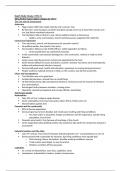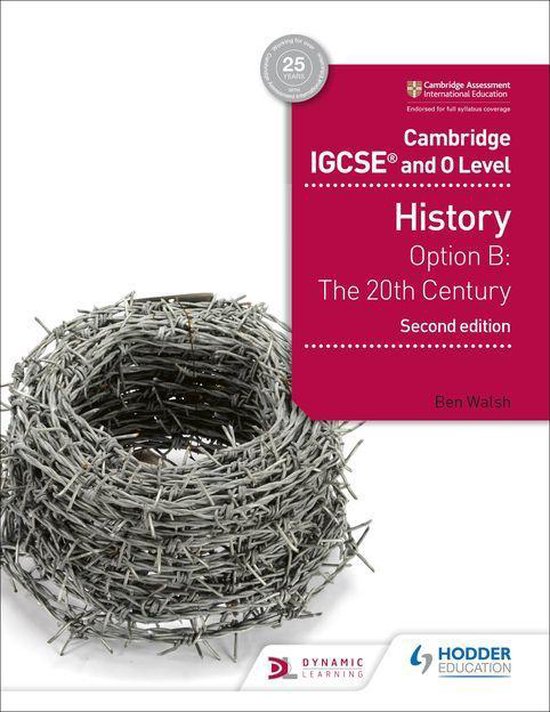Depth Study: Russia, 1905-41
Why did the Tsarist regime collapse by 1914?
The Tsar and his Government
Autocracy
Huge empire (300 miles wide) ruled by only 1 person: Tsar
By this time, most European countries had given people some say in how their country was
run, but Russia remained autocratic
Tsar Nicholas II did not listen to any calls for political reform or democracy
o Nobles, army commanders, church and bureaucracy supported him with this
Control and repression
Tsar used army, church, and bureaucracy for excessive control
No political parties, free speech, free press
Secret police, Okhrana, had 10 000 officers- exiled opposition to Siberia
o Army backed them up, particularly Cossacks
In the countryside, each peasant belonged to a mir (commune), ruled by a noble to solve
disputes
Larger areas ruled by governors (aristocrats appointed by the Tsar)
Some elected officials in towns and district councils- Zemstva- but these were dominated by
nobles and professionals (doctors, lawyers)
Zemstva did good work- health and education, experience in running local government
People wanted a national zemstvo to help run the country, tsar did not accept this
Chaos and incompetence
Tsar Nicholas was not a good ruler
Avoided big decisions, wasted time on small things
He felt threatened by able and talented ministers, refused to chair the Council of Ministers
(no confrontation)
Encouraged rivalry between ministers, causing chaos
Nepotistic, elected incompetent and corrupt officials, took bribes
The Russian people
Nationalities
Only 40% of Tsar’s subjects spoke Russian
Some nationalities were loyal (Cossacks), others (Finns, Poles) were not
Discrimination against Jews
Peasants and the countryside
80% of Russian population
Some prosperous farmers (kulaks), but mostly poor working and living conditions:
o No clean water or education, hunger and disease, low life expectancy, quickly rising
population, lack of land
Peasants were loyal to Tsar because of teachings of the church
Some supported radical political parties who wanted to take land from aristocrats and give it
to peasants
Industrial workers and the cities
Late 19th century: Tsars keen for Russian industrial growth: oil + coal production x3, iron x4
Some peasants left countryside for factories, but living conditions were equally bad:
o Slum housing, illness, alcoholism, horrible working conditions, low pay
o Trade unions were illegal, no way to protest
o Workers no better off than peasants
Capitalists
As a result of industrialism, new class, capitalists, arose
Landowners, industrialists, bankers, traders, businessmen
, These people increased the size of the middle class
Main concerns were managing economy and controlling workforce
Clashes between workers and capitalists
Political opposition to the Tsar
Moderates Wanted a constitutional democracy (don’t overthrow Tsar/Church) like Britain:
(liberals) Octobrists: more conservative, defended October Manifesto
Kadets: more radical
Both supported by middle classes
Nationalists Russians should be leading with strong Empire
Conservatives Opposed political change
Socialist Sharing out wealth for equal society
Revolutionaries Much peasant support
By 1917, SRs were a collection of left-wing groups instead of a united
party
Most revolutionary were the Left SRs- revolutionary action and
assassination of political enemies in ruling class
o Murdered government officials, Okhrana, spies
Social Socialists (Marxists)- believed history was decided by decided by struggle
Democrats between classes, as the proletariat would wise up in revolution and overthrow
capitalist owners of industry
They thought this would lead to fair, communist societies with no class
conflict
In 1903, social democrats split into Mensheviks and Bolsheviks:
Mensheviks thought Russia was not ready for revolution, wanted to
build a mass party with many workers and revolutionaries
o Fairly democratic, willing to work with other parties
Bolsheviks, led by Lenin, wanted to form a close group of professional
revolutionaries who wouldn’t co-operate with other parties
o Non-democratic- controlled by Lenin and Central Committee
The 1905 Revolution
Long-Term Causes of the 1905 Revolution – Political
Russia did not have a democratic system, the only elected organisations in Russia were the
Zemstva, and political parties were illegal
Political opposition developed along many different ideological lines, and was often divided,
but they all agreed that Russia needed to reform
There was a growing underground revolutionary movement which was inspired by Marxism,
and wanted to overthrow the Autocracy
There was also a developing Liberal movement, of people that wanted to move towards a
constitutional monarchy
Opposition was suppressed by the Okhrana (secret police), which had been founded by
Alexander II and hugely expanded by Alexander III in the 1880s
Long-Term Causes of the 1905 Revolution – Socio-Economic
The rapid industrialisation organised by Witte in the 1880s had led to Russia becoming a
powerful economy
However, there had been no effort to improve the lives of the people; working conditions in
cities were terrible, with workers renting a bed, having little to no time off, and receiving low
pay
The famine in 1891 had shown the success of the Zemstva in helping the people, which had
inspired the development of the Liberal movement, who wanted a parliament
, There was a lack of trade unions, so many workers turned to revolutionary groups
Peasants and workers in poor living conditions- 75% unhappy
Widespread hunger and famine, protests, and strikes
Little to protect low pay and safety of workers, ethnic minorities suppressed, unfair taxation
Low sanitation, horrible living conditions, high mortality rate
No form of representative government apart from Zemstvas, whose influence was greatly
reduced
Middle classes unhappy that they had no say in how the country was governed, much
opposition
Short-Term Causes of the Revolution – Defeat in Russo-Japanese War
Embarrassment of defeat to 'racially inferior' Asiatic power added to opinion of Tsar's
incompetence
Tsar agreed to humiliating defeat treaty
Defeat in war led to mutiny on Potemkin battleship- harder for Tsar to combat rebels
The war was unnecessary, increased hardships, and Russia was losing all battles
1904: Plehve assassinated by terrorist bomb
Tsar was an autocrat- could not fault the war on anyone else but himself
The war exacerbated social, political, and economic hardships as resources were diverted
Effects of Bloody Sunday sustained by Russo-Japanese War
Short-Term Causes of the Revolution – Bloody Sunday
Events of Bloody Sunday helped bring publicity of worsening political and social situation in
Russia
Events of Bloody Sunday aided aggravating the people and stimulating opposition,
encourages expressions of resistance
Spark which lit the fire for the revolution, pushed it over the tipping edge
Tsar was blamed, people thought he was aware of their issues but didn’t care- added to
growing feeling of disrespect- removal of 'little father'
Instead of care + consideration, they are met by bullets and sabres
Bloody Sunday was the final straw, and it would not have had the effect it did without long-
term inequalities
Bloody Sunday was a peaceful demonstration, with respect for Tsar (national anthems,
images of Tsar, crosses), but it was met with unnecessary force as soldiers fired on
protesters (including women and children)
o Occurred after 5 men were fired from the Putilov factory in St Petersburg, causing
105 000 workers to strike in the city, and a demonstration at the Winter Palace was
organised by Father Gapon- 200 killed, 800 wounded
Short-Term Causes of the Revolution – The October Manifesto and the Duma
The Tsar issued the October Manifesto, which created an elected Duma and seemed to
imply there would be further political reform in Russia
This had been on the advice of Witte, and was not popular with Nicholas II
The main way in which this helped to stop the protests was that it split opposition, as many
Liberals supported it
This led to the ending of the General Strike
There were also the ‘days of freedom’ after the manifesto, when there were celebrations
and the formation of political parties
There was further unrest in the countryside, which forced Witte to cancel the redemption
payments
1905 Timeline
, January
People’s protests led to petition presented to Tsar at Winter Palace on 9/22
March to Palace Square grew out of control to ~150,000 people
BLOODY SUNDAY – troops massacred people due to no police rifles caused 200+ deaths
17/30 general strike in protest of massacre failed to have an impact on the government
as they wanted to buy time for the war paralysis of economy
Tsar advised/declines creation of consultative government
Opponents of the Government had time to organise so government relaxed restrictions on
universities and proposed a consultative assembly due to risk of assassination
March
By spring 1905, St Petersburg university was free of police open political meetings
July
All Russian Peasants’ Union met in Moscow land issue + Gapon’s demands
August
Black Sea mutinies e.g. on Potemkin
September
(Constituent Assembly, hours of work regulation, measure of land redistribution) Demands
of Union of Unions were reaffirmed
How did the Tsar survive?
Tsarism in danger
Bloody Sunday started many strikes, riots, violence in streets
Tsar’s uncle (Grand Duke Sergei) assassinated, he lost respect and large areas of Russia
Opposition groups:
o Liberals and middle classes wanted civil rights and a say in government
o Students wanted freedom in universities
o Nationalities wanted independence
o They didn’t combine to form united opposition
Sailors on Potemkin mutinied, dangerous for the Tsar
Soviets (councils of workers) formed in cities, general strikes began, paralysing Russia
October Manifesto
Tsar was persuaded to issue October Manifesto as things had got so bad
It allowed people to have free speech and press, an elected parliament (Duma), and political
parties
It divided the Tsar’s opponents- some middle classes supported this
o SRs, Social Democrats, and Right Wing is unhappy (betrayal of autocracy)
The army restores tsarist rule
After troops returned from Japan, they could restore order more easily
In December 1905, leaders of St Petersburg and Moscow Soviet were arrested
o Fighting in Moscow, crushed by the army
In 1906, it took longer to keep peasants under control
o Tsar promised financial help to set up peasant’s bank to buy land
o In the end, troops were sent to crush peasants and nationalities
o Many executions/imprisonments, beatings, and rape
The troubled years, 1905-14
Tsar had just about survived- reform was needed to satisfy some opposition
Hopeful for the Duma to make change
Before the first meeting of the Duma, the Tsar releases the Fundamental Laws in May 1906
o Essentially tries to counteract (indirectly) the October Manifesto
First 2 Dumas were critical of the Tsar, did not last very long at all as they were left wing
In 1907, electoral laws changed so more nobles voted, and Tsar had a favourable Duma





